十三陵-神路英文介绍
- 格式:doc
- 大小:412.50 KB
- 文档页数:5
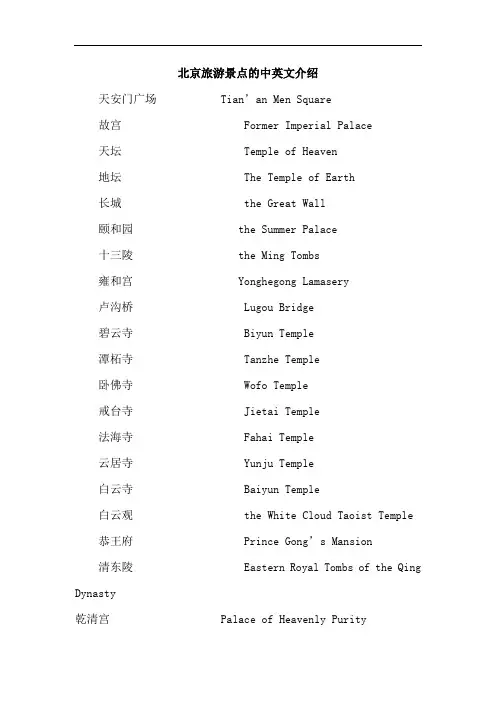
北京旅游景点的中英文介绍天安门广场 Tian’an Men Square故宫 Former Imperial Palace天坛 Temple of Heaven地坛 The Temple of Earth长城 the Great Wall颐和园 the Summer Palace十三陵 the Ming Tombs雍和宫 Yonghegong Lamasery卢沟桥 Lugou Bridge碧云寺 Biyun Temple潭柘寺 Tanzhe Temple卧佛寺 Wofo Temple戒台寺 Jietai Temple法海寺 Fahai Temple云居寺 Yunju Temple 白云寺 Baiyun Temple白云观 the White Cloud Taoist Temple恭王府 Prince Gong’s Mansion清东陵 Eastern Royal Tombs of the Qing Dynasty乾清宫 Palace of Heavenly Purity北海公园 Beihai Park香山公园 Xiangshan Park世界公园 Beijing World Park圆明园遗址 the Ruins of Yuanmingyuan北京动物园 Beijing Zoo 中华世纪坛 China Century Altar故宫博物院 the Palace Museum人民大会堂 the Great Hall of the People民族文化宫the Cultural Palace for Nationalities劳动人民文化宫 Working People's Cultural Palace北京工人体育馆 Beijing Worker's Stadium革命历史博物馆 the Museum of Revolutionary History。
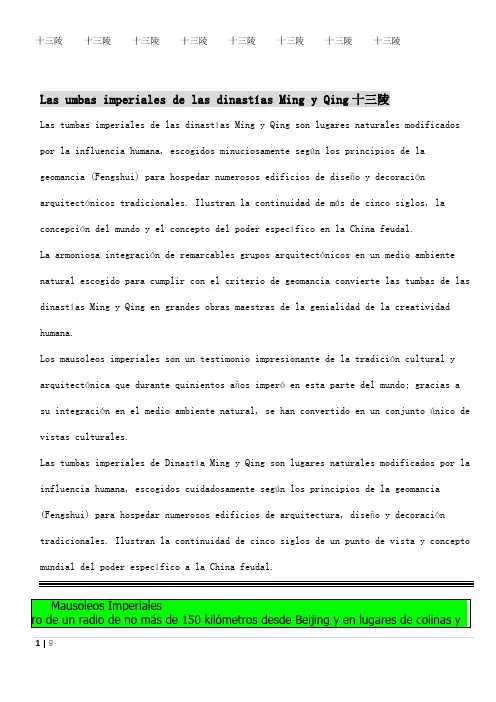
Las umbas imperiales de las dinastías Ming y Qing十三陵Las tumbas imperiales de las dinastías Ming y Qing son lugares naturales modificados por la influencia humana, escogidos minuciosamente según los principios de la geomancia (Fengshui) para hospedar numerosos edificios de diseño y decoraciónarquitectónicos tradicionales. Ilustran la continuidad de más de cinco siglos, la concepción del mundo y el concepto del poder específico en la China feudal.La armoniosa integración de remarcables grupos arquitectónicos en un medio ambiente natural escogido para cumplir con el criterio de geomancia convierte las tumbas de las dinastías Ming y Qing en grandes obras maestras de la genialidad de la creatividad humana.Los mausoleos imperiales son un testimonio impresionante de la tradición cultural y arquitectónica que durante quinientos años imperó en esta parte del mundo; gracias a su integración en el medio ambiente natural, se han convertido en un conjunto único de vistas culturales.Las tumbas imperiales de Dinastía Ming y Qing son lugares naturales modificados por l a influencia humana, escogidos cuidadosamente según los principios de la geomancia (Fengshui) para hospedar numerosos edificios de arquitectura, diseño y decoración tradicionales. Ilustran la continuidad de cinco siglos de un punto de vista y concepto mund ial del poder específico a la China feudal.9丽:裕,lo的十三陵十三陵十三陵十三陵十三陵十三陵十三陵十三陵10 | 9。
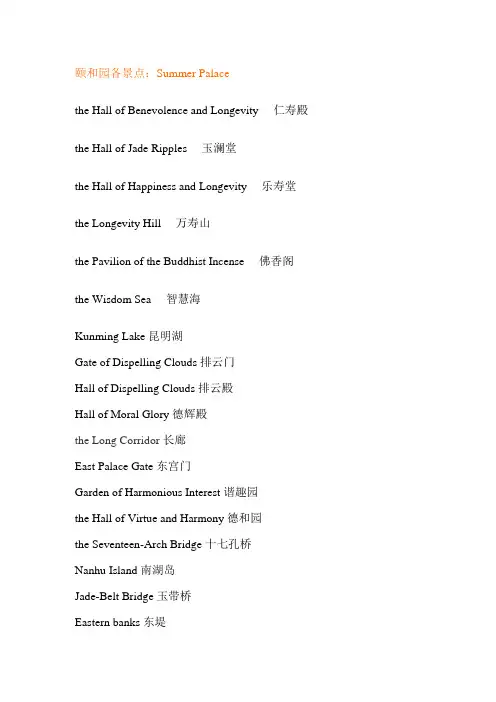
颐和园各景点:Summer Palacethe Hall of Benevolence and Longevity 仁寿殿the Hall of Jade Ripples 玉澜堂the Hall of Happiness and Longevity 乐寿堂the Longevity Hill 万寿山the Pavilion of the Buddhist Incense 佛香阁the Wisdom Sea 智慧海Kunming Lake昆明湖Gate of Dispelling Clouds排云门Hall of Dispelling Clouds排云殿Hall of Moral Glory德辉殿the Long Corridor长廊East Palace Gate东宫门Garden of Harmonious Interest谐趣园the Hall of Virtue and Harmony德和园the Seventeen-Arch Bridge十七孔桥Nanhu Island南湖岛Jade-Belt Bridge玉带桥Eastern banks东堤western bank西堤The Marble Boat石舫Jichang Garden寄畅园Chamber of Collecting Books宜芸馆Autumn Water Pavilion秋水亭故宫The Palace MuseumTiananmen Gate天安门The Purple Forbidden City紫禁城the Meridian Gate (Wu men)午门the Gate of Spiritual Valor神武门halls of Supreme Harmony太和殿This hall used to be the throne hall for ceremonies which marked great occasionsHalls of Central Harmony中和殿Here the emperor rehearsed for ceremoniesPreserving Harmony保和殿halls of Literary Glory文华殿Military Eminence武英殿the Palace of Heavenly Purity乾清宫the Hall of Union交泰殿the Palace of Earthly Tranquility坤宁宫the Imperial Garden御花园Hall of Mental Cultivation养心殿the Pavilion of the Rain of Flowers花雨亭the Palace of Benevolent Tranquility慈宁宫the halls for Worshipping Ancestors奉先殿the halls of Imperial Splendor皇极殿the Five-Phoenix Towers 五凤楼palace of peace and longevity宁寿宫east palaces东六宫west palaces西六宫Gate of Heavenly Purity乾清门Imperial study御书房Palace of eternal spring长春宫Chung wah palace重华宫明十三陵The Thirteen Tombs of the Ming Dynasty God way神路the stone arch石牌坊dragon Gate龙凤门Underground Palace 地宫Stele Pavilion碑亭左配殿 LEFT SIDE HALL中殿 MAIN HALL前殿 FRONT HALL后殿 BACK HALLThe Hall of Eminent Favor祾恩殿Blessing and Grace Gate祾恩门Sacred Silk Burner"神帛炉炉Soul Tower 明楼Five Sacrificial Utensils五供定陵是明朝第十个皇帝和他的两个皇后的墓Dingling is the tomb of the tenth emperor Wanli of the Ming Dynasty and his two empresses永陵Yongling, built in 1536, is the tomb for Emperor Shizong, Zhu Houcong (1507-1566). He stayed in power for 45 years.茂陵Maoling Tomb ,Emperor Xianzong, Zhu Jianshen, and his three empresses are entombed within Maoling长陵Changling is the tomb of emperor Yongle (reigned 1403-1424), the third emperor of the Ming Dynasty whose personal name was Zhu Di, and of his empress献陵emperor Renzong景陵emperor Xuanzong裕陵emperor Yingzong泰陵emperor Xiaozong康陵emperor Wuzong昭陵emperor Muzong庆陵emperor Guangling德陵emperor Jiazong思陵emperor chongzhen明成祖朱棣的长陵、仁宗献陵、宣宗景陵、英宗裕陵、宪宗茂陵、孝宗泰陵、武宗康陵、世宗永陵、穆宗昭陵、神宗定陵、光宗庆陵、熹宗德陵、崇祯思陵鸟巢the National Stadiumthe Olympic Green奥林匹克公园temporary seats临时座位The bowl碗状看台Beijing National Aquatics Center北京国家游泳中心Water Cube水立方天坛The Temple of Heaventhe inner altar内坛outer altar外坛the Imperial Vault of Heaven 皇穹宇the Circular Mound Altar 圜丘坛the Hall of Prayer for Good Harvests 祈年殿the Hall of Imperial Zenith 皇乾殿the Hall of Abstinence 斋宫the Echo Wall 回音壁Three Echo Stones三音石Southern Sacred Road南圣路The hall of abstinence斋宫Bell tower钟楼Nine-dragon cypress九龙柏Heaven` s Storehouse天库Red Stairway Bridge丹陛桥Costume-Changing Terrace具服台Heaven Kitchen神厨the Huanqian (Imperial heaven) Long corridor七十二长廊slaughterhouse宰牲亭长城the great wallBadaling Great Wall八达岭长城The ancient big gun古炮beacon tower烽火台dispatch wall堞墙the parapet女儿墙/宇墙JuYong pass居庸关。

十三陵The Ming Tombs雍和宫Yonghe Lamasery中华世纪坦China Century Altar秦始皇陵The Emperor Qin Shihuang's Tomb天安门广场Tian'anmen Square华表Ornamental Pillars人民英雄纪念碑The Monument to the People's Heroes 毛主席纪念堂Chairman Mao Memorial Hall人民大会堂The Great Hall of the People故宫The Forbidden City乾清宫The Palace of Heavenly Purity坤宁宫The Palace of Earthly Tranquility御花园The Imperial Garden九龙壁The Nine Dragon Screen天坛The Temple of Heaven回音壁Echo Wall祈年殿The Hall of Prayer for Good Harvest颐和园The Summer Palace佛香阁The Tower of Buddhist Incense石舫The Marble Boat十七孔桥The 17-Arch Bridge铜牛Bronze Ox谐趣园The Garden of Harmonious Interests长城The Great Wall居庸关Juyongguan Pass北海公园: Beihai Park故宫博物院: the Palace Museum革命历史博物馆: The Museum of Revolutionary History 天安门广场: Tian’anmen Square毛主席纪念堂:Chairman Mao Zedong Memorial Hall保和殿: the Hall of Preserving Harmony中和殿: the Hall of Central Harmony长城: the Great Wall午门: the Meridian Gate紫金山天文台: Purple and Gold Hills Observation紫禁城: the Forbidden City御花园: Imperial Garden颐花园: Summer Palace天坛: Temple of Heaven周口店遗址: Zhoukoudian Ancient Site太和殿: the Hall of Supreme Harmony祈年殿: the Hall of Prayer for Good Harvest.少年宫: the Children’s Palace烽火台: the Beacon Tower人民大会堂: the Great Hall of the People清东陵: Easten Royal Toms of the Qing Dynasty乾清宫: Palace of Heavenly Purity民族文化宫: the Cultural Palace for Nationalities劳动人民文化宫:Worker People’s Cultural Palace 北京工人体育馆:Beijing Workers’Stadium护城河: the Moat仙人洞: Fairy Cave黄果树瀑布:Huangguoshu Falls西山晴雪: the Sunny Western Hills after Snow避暑山庄:the Imperial Mountain Summer Resort龙门石窟: Longmen Cave苏州园林:Suzhou Gardens庐山:Lushan Mountain天池: Heaven Poll蓬莱水城: Penglai Water City大雁塔: Big Wild Goose Pagoda华山: Huashan Mountain峨眉山:Emei Mountain石林: Stone Forest西湖: West Lake白马寺: White Horse Temple白云山: White Cloud Mountain.布达拉宫:Potala Palace大运河: Grand Canal滇池: Dianchi Lake杜甫草堂: Du Fu Cottage都江堰: Dujiang Dam鼓浪屿: Gulangyu Islet观音阁: Goddess of Mercy Pavilion归元寺: Guiyuan Buddhist Temple甘露寺: Sweet Dew Temple黄花岗七十二烈士墓:Mausoleum of the 72 Martyrs 华清池: Huaqing Hot Spring昭君墓: Zhaojun’s Tomb毛泽东故居:Mao Zedong’s Former Residence周恩来故居:Zhou Enlai’s Former Residence越秀公园: Yuexiu Park岳阳楼: Yueyang Tower南湖公园: South Lake Park中山公园: Zhongshan Park漓江: Lijiang River寒山寺: Hanshan Temple静心斋: Heart-East Study黄鹤楼: Yellow Crane Tower黄山: Huangshan Mountain天下第一关:the First Pass Under Heaven桂林山水:Guilin Scenery with Hills and Waters秦始皇兵马俑: Qin Terra-Cotta Warriors and Horses Figurines HuaQING hot spring 华清池drum tower 鼓楼Great GOOSE pagoda 大雁塔the West Lake西湖泰山:Mount Taishan庐山:Mt. Lu 天安门及广场Tian'anmen and Tian'anmen Square 故宫The Palace Museum天坛The Temple of Heaven颐和园The Summer Palace长城The Great Wall(八达岭长城The Great Wall at Badaling居庸关长城The Great Wall at Juyongguan Pass慕田峪长城The Great Wall at Mutianyu司马台长城The Great Wall at Simatai)明十三陵The Ming Tombs北海公园Beihai Park雍和宫Yonghegong Larmasery白云观The White Cloud Taoist Temple北京孔庙Beijing Confucius Temple国子监The Imperial College潭柘寺Tanzhe Temple圆明园The Ruins of Yuanmingyuan周口店北京猿人遗址Peking Man Site at Zhoukoudian中华民族园Chinese Ethnic Culture Park世界公园Beijing World Park中华世纪坛China Century Altar桂林山水the Landscape of Guilin杭州西湖the West Lake of Hangzhou故宫the Imperial Palace苏州园林the Gardens of Suzhou安徽黄山Mount Huang of Anhui长江三峡the Three Gorges on the Yangtze River台湾日月潭the Sun and Moon Lake of Taiwan河北承德避暑山庄the Summer Mountain Resort in Chengde, Hebei 陕西秦始皇陵兵马俑Terra Cotta Warriors。
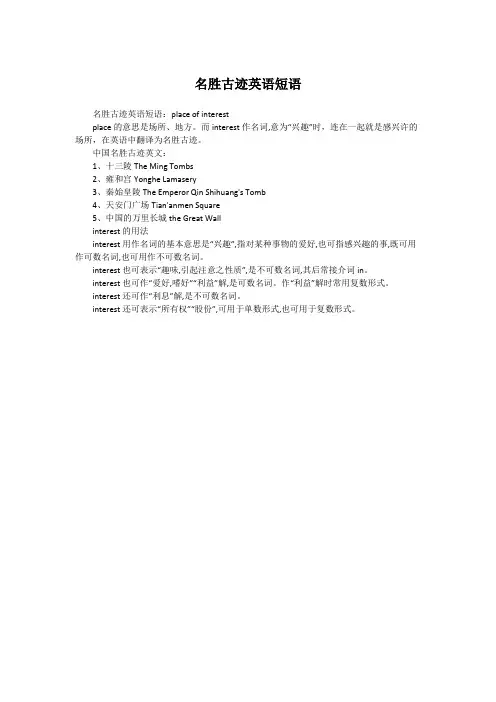
名胜古迹英语短语
名胜古迹英语短语:place of interest
place的意思是场所、地方。
而interest作名词,意为“兴趣”时,连在一起就是感兴许的场所,在英语中翻译为名胜古迹。
中国名胜古迹英文:
1、十三陵The Ming Tombs
2、雍和宫Yonghe Lamasery
3、秦始皇陵The Emperor Qin Shihuang's Tomb
4、天安门广场Tian'anmen Square
5、中国的万里长城the Great Wall
interest的用法
interest用作名词的基本意思是“兴趣”,指对某种事物的爱好,也可指感兴趣的事,既可用作可数名词,也可用作不可数名词。
interest也可表示“趣味,引起注意之性质”,是不可数名词,其后常接介词in。
interest也可作“爱好,嗜好”“利益”解,是可数名词。
作“利益”解时常用复数形式。
interest还可作“利息”解,是不可数名词。
interest还可表示“所有权”“股份”,可用于单数形式,也可用于复数形式。
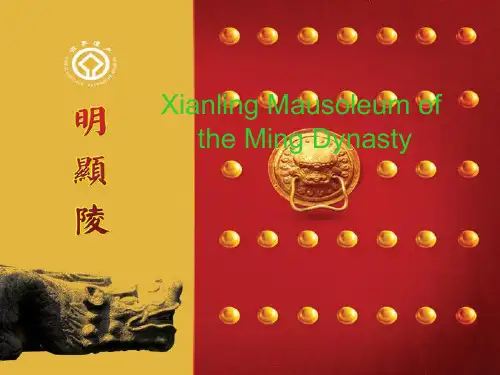
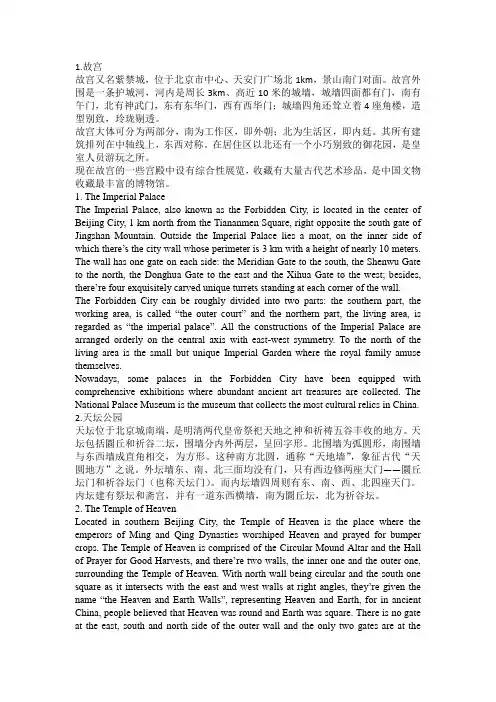
1.故宫故宫又名紫禁城,位于北京市中心、天安门广场北1km,景山南门对面。
故宫外围是一条护城河,河内是周长3km、高近10米的城墙,城墙四面都有门,南有午门,北有神武门,东有东华门,西有西华门;城墙四角还耸立着4座角楼,造型别致,玲珑剔透。
故宫大体可分为两部分,南为工作区,即外朝;北为生活区,即内廷。
其所有建筑排列在中轴线上,东西对称。
在居住区以北还有一个小巧别致的御花园,是皇室人员游玩之所。
现在故宫的一些宫殿中设有综合性展览,收藏有大量古代艺术珍品,是中国文物收藏最丰富的博物馆。
1. The Imperial PalaceThe Imperial Palace, also known as the Forbidden City, is located in the center of Beijing City, 1 km north from the Tiananmen Square, right opposite the south gate of Jingshan Mountain. Outside the Imperial Palace lies a moat, on the inner side of which there’s the city wall whose perimeter is 3 km with a height of nearly 10 meters. The wall has one gate on each side: the Meridian Gate to the south, the Shenwu Gate to the north, the Donghua Gate to the east and the Xihua Gate to the west; besides, there’re four exquisitely carved unique turrets standing at each corner of the wall.The Forbidden City can be roughly divided into two parts: the southern part, the working area, is called “the outer court” and the northern part, the living area, is regarded as “the imperial palace”. All the constructions of the Imperial Palace are arranged orderly on the central axis with east-west symmetry. To the north of the living area is the small but unique Imperial Garden where the royal family amuse themselves.Nowadays, some palaces in the Forbidden City have been equipped with comprehensive exhibitions where abundant ancient art treasures are collected. The National Palace Museum is the museum that collects the most cultural relics in China.2.天坛公园天坛位于北京城南端,是明清两代皇帝祭祀天地之神和祈祷五谷丰收的地方。
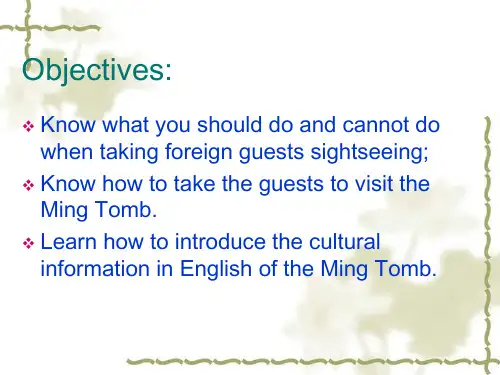
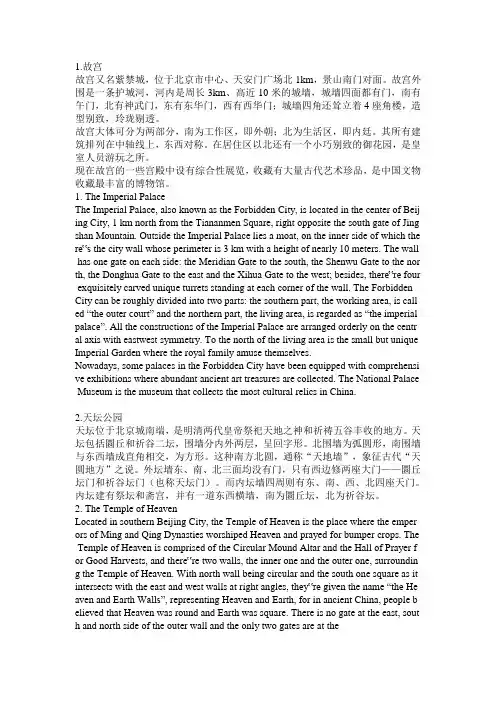
1.故宫故宫又名紫禁城,位于北京市中心、天安门广场北1km,景山南门对面。
故宫外围是一条护城河,河内是周长3km、高近10米的城墙,城墙四面都有门,南有午门,北有神武门,东有东华门,西有西华门;城墙四角还耸立着4座角楼,造型别致,玲珑剔透。
故宫大体可分为两部分,南为工作区,即外朝;北为生活区,即内廷。
其所有建筑排列在中轴线上,东西对称。
在居住区以北还有一个小巧别致的御花园,是皇室人员游玩之所。
现在故宫的一些宫殿中设有综合性展览,收藏有大量古代艺术珍品,是中国文物收藏最丰富的博物馆。
1. The Imperial PalaceThe Imperial Palace, also known as the Forbidden City, is located in the center of Beij ing City, 1 km north from the Tiananmen Square, right opposite the south gate of Jing shan Mountain. Outside the Imperial Palace lies a moat, on the inner side of which the re‟s the city wall whose perimeter is 3 km with a height of nearly 10 meters. The wall has one gate on each side: the Meridian Gate to the south, the Shenwu Gate to the nor th, the Donghua Gate to the east and the Xihua Gate to the west; besides, there‟re four exquisitely carved unique turrets standing at each corner of the wall. The Forbidden City can be roughly divided into two parts: the southern part, the working area, is call ed “the outer court” and the northern part, the living area, is regarded as “the imperial palace”. All the constructions of the Imperial Palace are arranged orderly on the centr al axis with eastwest symmetry. To the north of the living area is the small but unique Imperial Garden where the royal family amuse themselves.Nowadays, some palaces in the Forbidden City have been equipped with comprehensi ve exhibitions where abundant ancient art treasures are collected. The National Palace Museum is the museum that collects the most cultural relics in China.2.天坛公园天坛位于北京城南端,是明清两代皇帝祭祀天地之神和祈祷五谷丰收的地方。
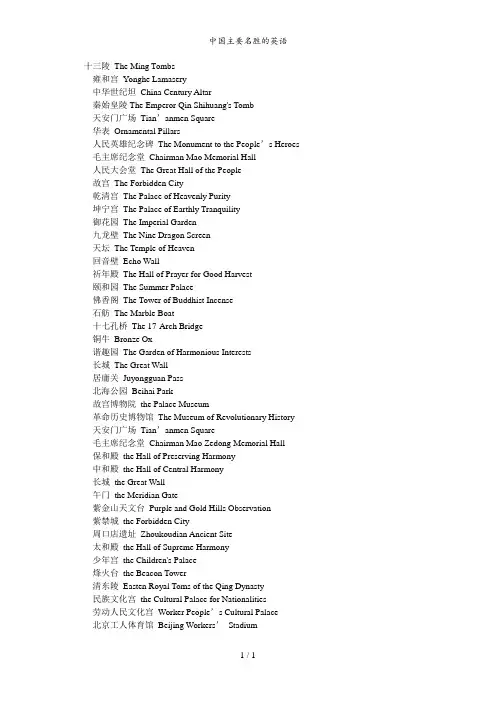
十三陵The Ming Tombs雍和宫Yonghe Lamasery中华世纪坦China Century Altar秦始皇陵The Emperor Qin Shihuang's Tomb天安门广场Tian’anmen Square华表Ornamental Pillars人民英雄纪念碑The Monument to the People’s Heroes 毛主席纪念堂Chairman Mao Memorial Hall人民大会堂The Great Hall of the People故宫The Forbidden City乾清宫The Palace of Heavenly Purity坤宁宫The Palace of Earthly Tranquility御花园The Imperial Garden九龙壁The Nine Dragon Screen天坛The Temple of Heaven回音壁Echo Wall祈年殿The Hall of Prayer for Good Harvest颐和园The Summer Palace佛香阁The Tower of Buddhist Incense石舫The Marble Boat十七孔桥The 17-Arch Bridge铜牛Bronze Ox谐趣园The Garden of Harmonious Interests长城The Great Wall居庸关Juyongguan Pass北海公园Beihai Park故宫博物院the Palace Museum革命历史博物馆The Museum of Revolutionary History 天安门广场Tian’anmen Square毛主席纪念堂Chairman Mao Zedong Memorial Hall保和殿the Hall of Preserving Harmony中和殿the Hall of Central Harmony长城the Great Wall午门the Meridian Gate紫金山天文台Purple and Gold Hills Observation紫禁城the Forbidden City周口店遗址Zhoukoudian Ancient Site太和殿the Hall of Supreme Harmony少年宫the Children's Palace烽火台the Beacon Tower清东陵Easten Royal Toms of the Qing Dynasty民族文化宫the Cultural Palace for Nationalities劳动人民文化宫Worker People’s Cultural Palace北京工人体育馆Beijing Workers’Stadium护城河the Moat仙人洞Fairy Cave黄果树瀑布Huangguoshu Falls西山晴雪the Sunny Western Hills after Snow避暑山庄the Imperial Mountain Summer Resort龙门石窟Longmen Cave苏州园林Suzhou Gardens庐山Lushan Mountain天池Heaven Poll蓬莱水城Penglai Water City大雁塔Big Wild Goose Pagoda华山:Huashan Mountain峨眉山Emei Mountain石林Stone Forest西湖West Lake白马寺White Horse Temple白云山White Cloud Mountain。

明十三陵神路简介咱们聊聊明十三陵神路,这地儿可不光是个陵墓群,它还是历史的见证,文化的瑰宝,一走进这地界儿,就像是穿越回了明朝,那味儿,那景儿,绝了!一踏上神路,你首先会瞅见一座雄伟的石牌坊,这牌坊啊,可不是一般的石头堆出来的,它是用青白石精雕细琢出来的,高高大大,像座城门楼子似的,总共有十一座楼,五间六柱,看着就让人心里头肃然起敬。
这牌坊是嘉靖皇帝特意为表彰祖先建的,说是要显摆显摆老祖宗的丰功伟绩,结果还真就成了个标志性的建筑,走到这儿,你就知道,明十三陵到了。
再往前走,就是大红门了,这大红门,红墙黄瓦,气派得很,跟故宫的门楼子有一拼。
它不光好看,规矩还多着呢,中间那个门是皇帝、皇后棺椁走的,左边是皇帝自己走的,右边呢,大臣们才用。
那时候的规矩,可严了,大臣们来这儿,得提前下马,步行进去,以示尊敬。
这大红门两边,还立着下马碑,上面写着“官员人等至此下马”,字儿刻得跟刀刻似的,清清楚楚,告诉你,进了这地界儿,就得守规矩。
穿过大红门,神路就正式开始了,这路啊,不直溜,弯弯绕绕的,据说是因为风水好,生旺而弯环则吉嘛。
路两边,一排排的石像生,就跟站岗的士兵似的,威严得很。
这些石像啊,有狮子、獬豸、骆驼、大象、麒麟、马,还有文臣武将,一个个雕刻得栩栩如生,跟真的一样。
特别是那狮子,瞪着大眼睛,张着大嘴,好像随时要扑过来似的,看着就让人心里头打鼓。
再往北走,就到了长陵神功圣德碑亭了,这亭子啊,四四方方的,重檐歇山顶,看着就稳当。
亭子里头立着一座大石碑,碑上刻着明仁宗朱高炽写的碑文,那字儿,龙飞凤舞的,漂亮极了。
碑的背面还有乾隆爷的诗,嘉庆爷的文章,这都是历史名人留下的墨宝啊。
过了碑亭,就是棂星门了,这门啊,也叫龙凤门,因为帝后的棺椁都是从这儿进陵区的。
门上头还雕着火焰宝珠,看着就喜庆。
进了这门,就算是进了陵区里头了,那气氛啊,就更不一样了,感觉就像是走进了另一个世界。
这神路啊,不光是条路,它还是条历史的长廊,文化的走廊。
北京名胜长城The Great Wall华表Ornamental Pillars石舫The Marble Boat天坛The Temple of Heaven地坛The Temple of Earth日坛The Temple of the Sun月坛The Temple of the Moon故宫The Forbidden City铜牛Bronze Ox午门The Meridian Gate太庙Imperial Ancestral Temple紫禁城the Forbidden City回音壁Echo Wall十三陵The Ming Tombs雍和宫Yonghe Lamasery颐和园The Summer Palace圆明园Old Summer Palace佛香阁The Tower of Buddhist Incense乾清宫The Palace of Heavenly Purity坤宁宫The Palace of Earthly Tranquility御花园The Imperial Garden九龙壁The Nine Dragon Screen谐趣园The Garden of Harmonious Interests居庸关Juyongguan Pass保和殿The Hall of Preserving Harmony中和殿The Hall of Central Harmony太和殿The Hall of Supreme Harmony祈年殿The Hall of Prayer for Good Harvest烽火台The Beacon Tower清东陵Easten Royal Toms of the Qing Dynasty 乾清宫Palace of Heavenly Purity雍和宫The Lama Temple白云观The White Cloud Taoist Temple国子监The Imperial Academy潭柘寺Tanzhe Temple秦始皇陵The Emperor Qin Shihuang's Tomb 十七孔桥The 17-Arch Bridge北海公园Beihai Park明十三陵The Ming Tombs北京孔庙Beijing Confucius Temple故宫博物院the Palace Museum中华世纪坛China Century Altar天安门广场Tian'anmen Square人民大会堂The Great Hall of the People周口店遗址Zhoukoudian Ancient Site民族文化宫The Cultural Palace for Nationalities北大博雅塔Beijing University Learned Tower毛泽东纪念堂Mao Zedong Memorial Hall宣武门天主堂The Cathedral of the Immaculate Conception(这是阿迪编写的北京名胜分类词汇,有编写错误的或者有补充的请QQ我:34833868)劳动人民文化宫Working People's Cultural Palace人民英雄纪念碑The Monument to the People's Heroes革命历史博物馆The Museum of Revolutionary History北京工人体育馆Beijing Workers’Stadium。
明孝陵旅游地介绍英语作文Ming Xiaoling is a famous tourist attraction in Nanjing.It is the tomb of Zhu Yuanzhang, the first emperor of theMing Dynasty. The tomb is surrounded by beautiful gardens,lush forests, and ancient stone sculptures. Visitors can explore the grand gate, sacred way, and main hall of the tomb, which are all well-preserved and offer a glimpse into the grandeur of the Ming Dynasty.One of the highlights of Ming Xiaoling is the Sacred Way, a long pathway lined with stone statues of mythical beasts, officials, and animals. The statues are exquisitely carvedand represent the power and authority of the Ming emperors. Walking down the Sacred Way, visitors can imagine what it would have been like to enter the tomb in ancient times.Another must-see at Ming Xiaoling is the main hall, where the emperor's spirit tablet is enshrined. The main hall is amagnificent structure with intricate carvings and colorful paintings on the walls and ceilings. Visitors can pay their respects to the emperor and learn more about his life and accomplishments.In addition to exploring the tomb itself, visitors can also enjoy the beautiful gardens surrounding Ming Xiaoling. The gardens are filled with ancient trees, blooming flowers, and tranquil ponds. It is a peaceful and serene place to take a leisurely stroll and appreciate the beauty of nature.Overall, Ming Xiaoling is a fascinating tourist destination that offers a glimpse into China's rich history and culture. Visitors can explore the grand tomb, admire the beautiful gardens, and learn more about the Ming Dynasty. It is a must-visit for anyone interested in Chinese history and architecture.。
北京十三陵神路景区介绍北京十三陵神路景区位于北京市昌平区,是中国明、清两代皇帝的陵墓群,被誉为中国明清古建筑艺术的瑰宝,是中国历史文化遗产的重要组成部分。
景区总面积约80平方公里,包括13座明代皇陵和一座清代皇陵,是中国现存最完整的皇家陵园之一。
这里有著名的定陵、长陵、昌陵等陵墓,以及景泰陵、神路等陵园建筑,是研究中国古代皇家陵墓文化的重要遗址。
神路是十三陵景区的重要景点之一,它是明十三陵中的一部分,是连接定陵和长陵的陵道,全长7.5公里。
神路始建于明朝,修建时间长达12年,是中国古代陵墓建设的杰作之一。
神路两侧种植着密密麻麻的松柏树,树高达20多米,形成了一道绿色长廊,给人以庄严肃穆之感。
沿着神路前行,可以欣赏到美丽的自然风光和古老的建筑群,感受到浓厚的历史文化氛围。
神路的两侧有许多古建筑和景点,其中最著名的是景泰陵和神道。
景泰陵是明成祖朱棣和明仁宗朱高炽的陵墓,是十三陵中规模最大、保存最完整的陵墓之一。
陵墓建筑坐北朝南,由前陵、中陵和后陵组成,整个建筑群宏伟壮观,富丽堂皇,是中国古代陵墓建筑的典范之一。
景泰陵的神道是连接陵墓和神路的主要通道,两侧石狮、石马、石人等雕塑栩栩如生,给人以庄严肃穆的感觉。
除了景泰陵和神道,神路还有许多其他景点值得一游。
比如,有一座古老的牌坊,上面雕刻着精美的花纹和文字,显示出明代建筑艺术的精湛工艺。
还有一座古井,据说是为了供奉陵墓中皇帝的神灵而修建的,至今仍保存完好。
此外,神路两旁还有一些古石刻和碑文,记录了明代皇帝的事迹和功绩,给人们了解古代历史提供了重要的资料。
在神路旁边,还有一些休闲娱乐设施和服务设施,如茶馆、餐厅、纪念品店等,为游客提供了便利。
游客可以在这里品尝到正宗的中国茶,品味到中国传统文化的魅力。
此外,景区还有专门的讲解员和导游,可以为游客提供全面的讲解和导览服务,让游客更好地了解十三陵的历史和文化。
总的来说,北京十三陵神路景区是一处集自然风光、古建筑和历史文化于一体的旅游胜地。
十三陵神路- God Way Ming Tombs明十三陵是明朝十三个皇帝的陵墓所在地,距今已五百多年,属国家重点文物保护单位,九二年被列为世界之最。
Ming Tombs is the tomb of Emperor Ming 13 seat, has been 500 years ago, a national key cultural relics protection units, 2092 is listed as the world's most神路是明十三陵的第一个景点,由石牌坊,大红门,碑楼,石象生,龙凤门等组成。
God Way is the first spots the Ming Tombs, the stone arch, dahongmen, Bei Lou, Dan Xiangsheng, Dragon Gate and other components.长陵神功圣德碑亭,内竖碑一座,龙首龟缺,高8.1米,碑阳刻明仁宗朱高炽撰写的碑文,三千馀字,碑阴刻清高宗乾隆“哀明陵三十韵”,碑东侧是乾隆五十二年刻的御制诗,西侧是清仁宗嘉庆九年的御制文。
碑亭四角,各有汉白玉华表一座,表顶各有异兽一尊,面南者称望君出。
面北者称望君归。
每座华表上共刻有四十一条龙。
Changlingji divine holiness Beiting, a monument erected within the dragon turtle missing the first high 8.1 m, monument carved out of high Chi-Ren Zhu, written inscriptions, San Qianyu words, reverse side of a stone tablet engraved Qing Gaozong Emperor Qianlong, "Yun Ai Ming Tombs, 30" , monument east is five years of the Qianlong Emperor carved poems, the west side of the Qing Ren Wen Emperor Jiaqing nine. Beiting corners, each with a white marble ornamental columns, animals have a table top, face south, said Wang Jun were out. Wang Jun said the North side return. China table of each block there are 40 carved dragon.碑亭北依次排列大型石雕。
有望柱二尊,坐立狮二对,坐立獬豸二对,立卧骆驼二对,立卧麟麟二对,立卧马二对,持瓜盔甲将军二对,朝衣冠文臣像二对,朝衣冠勋臣像二对,北接三门六柱式的棂星门,也称火焰牌坊,俗称龙凤门。
Beiting North turn arranged a large stone. Expected to column 2, two pairs of lions sitting, sitting haitai 二right, vertical-horizontal camel 二right, vertical-horizontal Lin Rinji right, vertical-horizontal horses two pairs of holding a melon helmet General II of the DPRK as two pairs of dressed Wenchen towards dressed Xunchen as two pairs of the north star 3 6 column of the lattice door, also known as the flame through the arch, commonly known as the Dragon Gate.石象生造型生勤,雕工精细,具有很高的文物和艺术债值。
Health Qin Shi Xiangsheng style, fine workmanship, high debt cultural and artistic value.石牌坊,它是我国现存最大的一座石制牌坊,全部是仿木结构,共五间六柱十一楼。
石牌坊为陵区前的第一座建筑物,建于1540年(嘉靖十九年)。
牌坊结构为五楹、六柱、十一楼,全部用汉白玉雕砌,在额枋和柱石的上下,刻有龙、云图纹及麒麟、狮子等浮雕。
这些图纹上原来曾饰有各色彩漆,因年代久远,现已剥蚀净尽。
整个牌坊结构恢宏,雕刻精美,反映了明代石质建筑工艺的卓越水平。
Stone arch, which is one of China's largest existing stone arch, all wood structure, a total of 11 floor, five six columns. Stone arch for the hilly area before the first building, built in 1540 (Jiajing 19 years). Arch structure for the five-ying, six columns, 11 floor, all with white marble Diao Qi,Fang and pillars in the amount of up and down, engraved with dragons, clouds Patterns and unicorn, lion and other relief. The Patterns of the original paint has been decorated with various colors, as was so long ago, has eroded the net do. Magnificent structure of the arch, carved stone buildings reflect the Ming process excellence.过了石牌坊,即可看到在神道左、右有两座小山。
东为龙山(也叫蟒山),形如一条奔越腾挪的苍龙;西为虎山(俗称虎峪),状似一只伏地警觉的猛虎。
中国古代道教有“左青龙,右白虎”为祥瑞之兆的传说,“龙”、“虎”分列左右,威严地守卫着十三陵的大门。
After a stone arch, you can see in the Shinto left and right are two hills. East for the Longshan (also called Mangshan), shaped like a dragon of Ben more maneuvers; West to Tiger Mountain (commonly known as Huyu), seemed to be an awareness of the Tigers fell to the ground. Ancient Chinese Taoism has "left the Green Dragon, White Tiger Right," for the good fortune of the legend, "Dragon," "Tiger," points out about awesome guarded the door to the Ming Tombs.大红门,制如宫门,两侧各有下马碑一座,上刻:“官员人等至此下马”,是皇权至高无上的象征。
大红门坐落于陵区的正南面,门分三洞,又名大宫门,为陵园的正门。
大门两旁原各竖一通石碑,上刻"官员人等至此下马"字样。
凡是前来祭陵的人,都必须从此步入陵园,以显示皇陵的无上尊严。
大门两侧原设有两个角门,并连接着长达80华里的红色围墙。
在蜿蜒连绵的围墙中,另设有一座小红门和十个出入口,均派有重兵驻守,是百姓不可接近的禁地。
现在这些围墙都早已坍塌,有些残迹尚依稀可辨。
Dahongmen, system such as the palace, one on each side dismount monument, inscribed: "At this point dismount and other officials who" is the supreme symbol of imperial power. Dahongmen is located in the hilly area of the south, the door in three holes, also known as a large palace, the cemetery's main entrance. The vertical sides of a door through the original stone tablets, inscribed "official persons to this dismount" words. All who come to Ji Ling, must be entered from this cemetery to show the imperial tombs of the supreme dignity. There are two doors on both sides of the original Jiao Men, and connect with up to 80 li of the red wall. Continuous walls in the winding, the other with a Xiaohongmen and 10 entrances were sent there massive presence, is not the people close to the forbidden. Now those walls have already collapsed, and some remnants are still faintly visible.大红门后的大道,叫神道,也称陵道。